Three hours from Cusco, Festivity Virgen Del Carmen Paucartambo is celebrated every year, a small, charming bridge of stone, built in Colonial times, leads into the town of Paucartambo. Its strategic location at the entry to the rich jungle territories where the people pratice the Andean Agriculture even on the eastern side of the region made this an important town in Inca and Colonial times.
Each year, on July 15, 16 and 17, Paucartambo regains its lost splendor with its beautiful celebration of the feast of the Virgen Del Carmen. The best part of the festival are their dance troupes. More dancers turn out for this eventhan for any other religious feast in Cusco, to honor the venerated image with their dances. The most renowned troupes are the Capac Colla, the Capac Chunchu, the Capac Negro and the Contradanza.
The elaborate choreography and de dancers' colorful costumes and unique masks are not the only interesting aspects of Paucartambo's dance; the dances aIso offer a summary of Cusco's history. For example, the dance of Chunchus represents the jungle ethnic groups in Inca Times, the Capac Negro dance evokes the slaves who worked on the Colonial haciendas in eastern Cusco and the dance of Auca Chilenos parodies the Chileans who invaded Peru in the late nineteenth century during the War of the Pacific.
Like all religious feasts in the Andes, the feast of the Virgen Del Carmen has a socially complex organization and an elaborate script like Lord Qoyllority Feast. The religious ceremonies held inside the church are an important part of the celebrations. Another, no Iess important custom relates to the dancing, the food and the drink is private in nature, taking place in the homes of the steward of the Virgin's brotherhood and the majordomos of the dance troupes.
Many festivities also take place in the Main Square and streets of Paucartambo, combining devotion to the Virgin with the pageantry of folk performances. The most important of these takes place on the eve of the feast day and on the feast day itself (July 15 and 16). On July 17, the third day of celebration. There is also a curious performance known as the guerilla, or little war.
A firework rocket launched from the steward’s home at midday signals the beginning of the feast of Paucartambo. Fireworks bursting all over town and the pealing church bells provide a background for the entry of the dance troupes around one or two in the afternoon.
Each group of dancers leaves the home of their respective carguyoc, to make its way to the entrance to church. Here they take turns singing and dancing in tribute to the Virgin, entertaining visitors with their variety of choreographies and the richness and exquisiteness of their costumes. On the eve of the feas day, after the Mass, at night in the main square of Paucartambo the party continues, bonfires are lit and they enjoy the fireworks display.
The bonfires represent purgatory and hell and many dancers jump over them, while other troupes dance in anorher parts of the square. Later, near midnight, the steward's band of musicians begins a serenade to the Virgin at the entrance to the church. Each dance band takes its turn and Paucartambo celebrates through the night.
The most significant religious ceremonies are held on July 16, the central feast day. They begin with a sunrise Mass at five in the morning and the solemn feast Mass at nine thirty. It is traditional for the Capac Colla and Capac Negro dance troupes to take part in the second Mass, competing to offer the best songs to the Virgin of Paucartambo.
After Mass, the crowd spills out into the main square for the traditional bosque. This is a wooden platform. from which the Capac Colla dancers throw Iarge quantities of fruit from the neighbouring areas on the edge of the jungle, especially oranges, and little bags called kintu, containing rice, coffee and coca leaves, as well as tiny chairs, tables, distaffs and mills made of wood.
At midday. The steward of the feast puts on a lunch for the town authorities and their guets, generally serving suckling pig, tamales and moraya, similar lunches take place in the homes of the various majordomos of the dance troupes. Then, beginning at three in the afternoon, the image of the Virgin is carried in procession around the square and along the main streets of the town. The most interesting part is when the Saqra, or devils, attempt to hide from the eyes of the Virgin as she passes. Climbing onto roofs and balconies, they alarm and entertain the crowd with their daring feats of balance.
On July 17th, the members of the different dance troupes make a pilgrimage, dancing through the srreets of the town to the cemetery, to render a touching tribute to departed dancers. In the afternoon, the Virgin makes another procession to the Carlos III Bridge, where she gives her blessing to the four cardinal points and to the Mapacho River, so its turbulent waters will not bring disaster to the towns along its banks.
The event most anticipated by those who travel to Paucartambo for the feast, however, is the guerilla a performance that pits the Chunchu and Colla dance troupes against each other and symbolizes the legendary rivalry between the people of the Inca regions of Antisuyo and Collasuyo.
The "war" begins when the Collas pitch their camp in the main square and leave it in the care of the imilla, the Colla, the only woman who dances with the troupe. Then the Chunchus appear and use deceit to win over the Collas, distract them and kidnap the imilla.
The two groups then enact a battle, in which the Chunchus are always triumphant and their king struts proudly past the body of the Colla chief, with the fickle imilla on his arm. The climax of this drama is the appearance of the saqra, or devils, bringing carts to gather up the bodies of the dead on both sides.
The feast of the Virgen Del Carmen also provides an opportunity to visiy Tres Cruces. One hours and half from Paucartambo and some four thousand meters above sea level, this outlook point on the eastern range of the Andes provides a magnificent view over the Amazon plain. The sunrise from here is spectacular.
FAQs Virgin of Carmen Festival Paucartambo
What is the Virgin of Carmen Festival Paucartambo?
The Virgin of Carmen Paucartambo Festival is a religious and cultural celebration held annually in Paucartambo, Cusco, on the 15th, 16th, and 17th of July. It is famous for its traditional dances, such as those of the Capac Colla, Capac Chunchu, and Capac Negro, which celebrate devotion to the Virgin with elaborate choreographies and costumes.
Where is the Virgin of Carmen Festival celebrated?
The festival is celebrated in the city of Paucartambo, located three hours from Cusco. The city, which was important during both the Inca and colonial periods, is known for its colonial architecture and its strategic location at the entrance to the Amazon jungle.
When is the Virgin of Carmen Festival celebrated?
The festival takes place annually on the 15th, 16th, and 17th of July. These days are celebrated with processions, dances, and other events in honor of the Virgin of Carmen.
What are the dance groups in the festival?
The dance groups are groups of dancers that perform elaborate choreographies in honor of the Virgin of Carmen. The most famous groups include the Capac Colla, Capac Chunchu, Capac Negro, and Contradanza, each representing historical and cultural aspects of the Cusco region.
What does the "guerrilla" mean in the festival?
The "guerrilla" is a symbolic performance in which the dance groups Capac Chunchu and Capac Colla face off against each other, representing the historical rivalry between the regions of Antisuyo and Collasuyo during the Inca Empire. This "battle" is a theatrical act that captivates the audience during the festival.
How do the celebrations of the festival begin?
The festival begins with a rocket of fireworks launched from the mayor's house at noon, signaling the start of the celebrations. Fireworks explode throughout the city, and the church bells ring, announcing the arrival of the dance groups in the plaza.
What is the "war of fireworks" in the festival?
The "war of fireworks" is a fireworks display held at night in the main square of Paucartambo. During the festival, bonfires are also lit, representing purgatory and hell, while dancers jump over them as part of the ritual.
What religious activities are held during the festival?
The religious activities include solemn masses and processions in honor of the Virgin of Carmen. The most important ceremony is held on the 16th of July, with a dawn mass and a solemn mass at 9:30 am, where the dance groups compete to offer the best songs to the Virgin.
What are the most representative dances of the festival?
The most representative dances are those of the Capac Colla, representing Inca nobility, the Capac Chunchu dance, which evokes the jungle peoples, and the Saqra dance, or demons, who perform a comic and challenging role during the celebrations.
What is the "traditional forest" during the festival?
The "traditional forest" is a wooden platform from which the dancers of Capac Colla throw fruits, such as oranges, and small packages called kintu that contain rice, coffee, coca leaves, and other symbolic items to the crowd as part of the ritual.
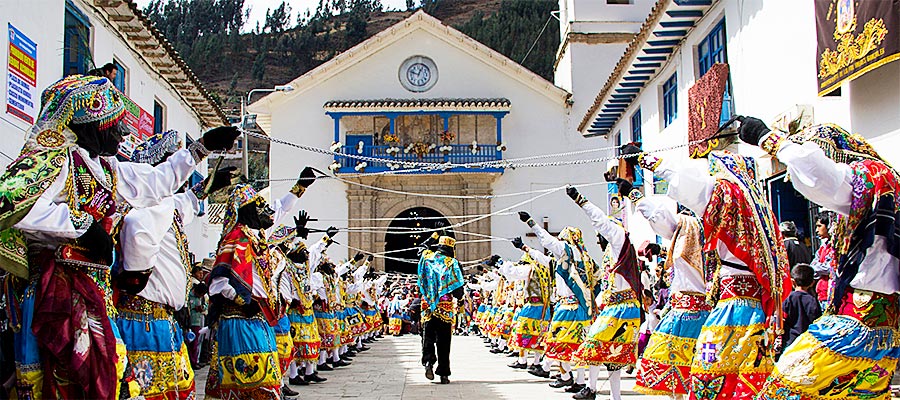

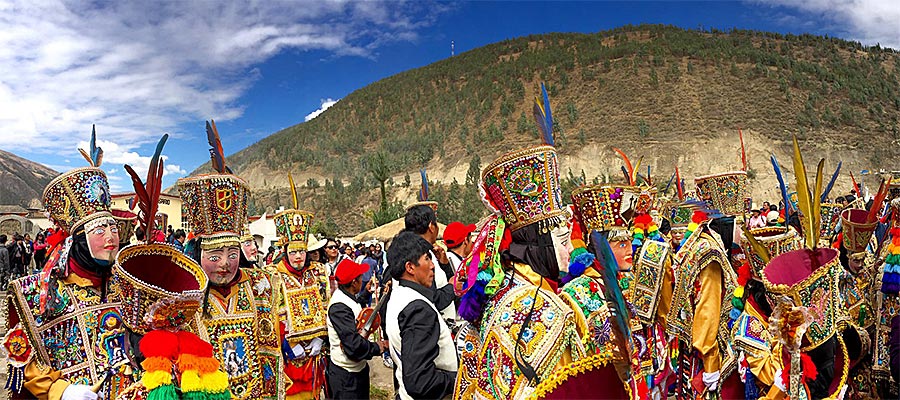
Leave us your comment